Florian Metze
Masked Autoencoders that Listen
Jul 13, 2022
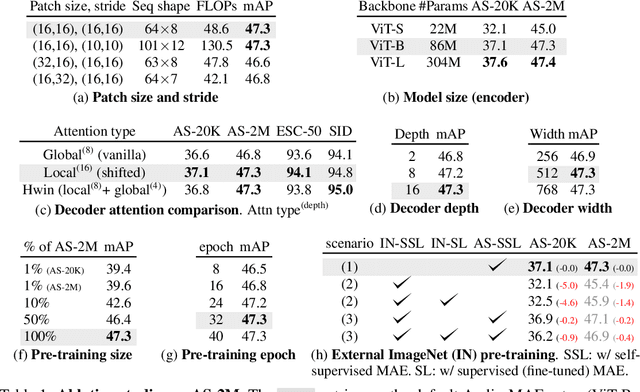

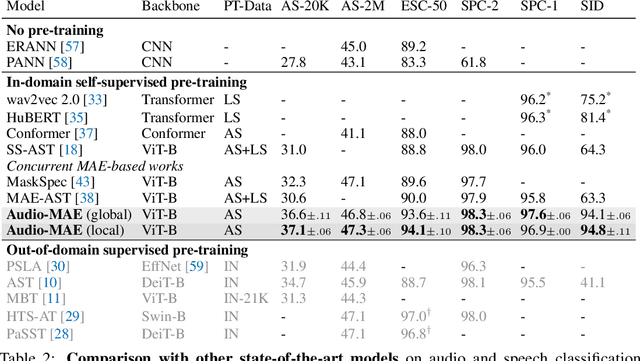
Abstract:This paper studies a simple extension of image-based Masked Autoencoders (MAE) to self-supervised representation learning from audio spectrograms. Following the Transformer encoder-decoder design in MAE, our Audio-MAE first encodes audio spectrogram patches with a high masking ratio, feeding only the non-masked tokens through encoder layers. The decoder then re-orders and decodes the encoded context padded with mask tokens, in order to reconstruct the input spectrogram. We find it beneficial to incorporate local window attention in the decoder, as audio spectrograms are highly correlated in local time and frequency bands. We then fine-tune the encoder with a lower masking ratio on target datasets. Empirically, Audio-MAE sets new state-of-the-art performance on six audio and speech classification tasks, outperforming other recent models that use external supervised pre-training. The code and models will be at https://github.com/facebookresearch/AudioMAE.
LegoNN: Building Modular Encoder-Decoder Models
Jun 07, 2022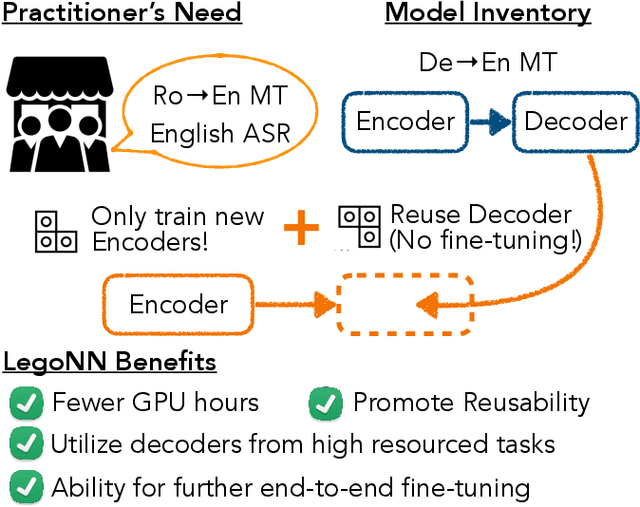
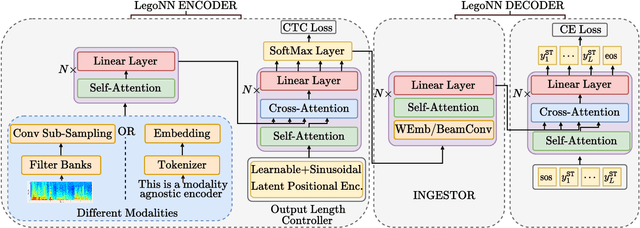
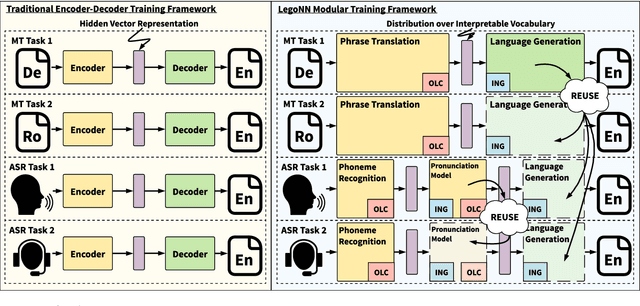

Abstract:State-of-the-art encoder-decoder models (e.g. for machine translation (MT) or speech recognition (ASR)) are constructed and trained end-to-end as an atomic unit. No component of the model can be (re-)used without the others. We describe LegoNN, a procedure for building encoder-decoder architectures with decoder modules that can be reused across various MT and ASR tasks, without the need for any fine-tuning. To achieve reusability, the interface between each encoder and decoder modules is grounded to a sequence of marginal distributions over a discrete vocabulary pre-defined by the model designer. We present two approaches for ingesting these marginals; one is differentiable, allowing the flow of gradients across the entire network, and the other is gradient-isolating. To enable portability of decoder modules between MT tasks for different source languages and across other tasks like ASR, we introduce a modality agnostic encoder which consists of a length control mechanism to dynamically adapt encoders' output lengths in order to match the expected input length range of pre-trained decoders. We present several experiments to demonstrate the effectiveness of LegoNN models: a trained language generation LegoNN decoder module from German-English (De-En) MT task can be reused with no fine-tuning for the Europarl English ASR and the Romanian-English (Ro-En) MT tasks to match or beat respective baseline models. When fine-tuned towards the target task for few thousand updates, our LegoNN models improved the Ro-En MT task by 1.5 BLEU points, and achieved 12.5% relative WER reduction for the Europarl ASR task. Furthermore, to show its extensibility, we compose a LegoNN ASR model from three modules -- each has been learned within different end-to-end trained models on three different datasets -- boosting the WER reduction to 19.5%.
On Advances in Text Generation from Images Beyond Captioning: A Case Study in Self-Rationalization
May 24, 2022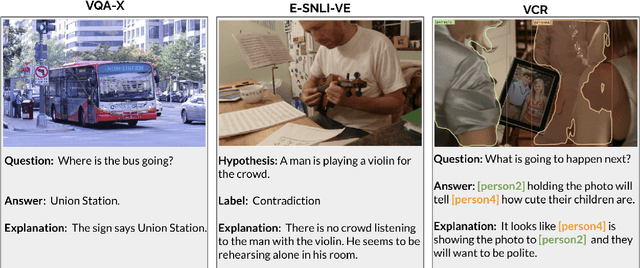
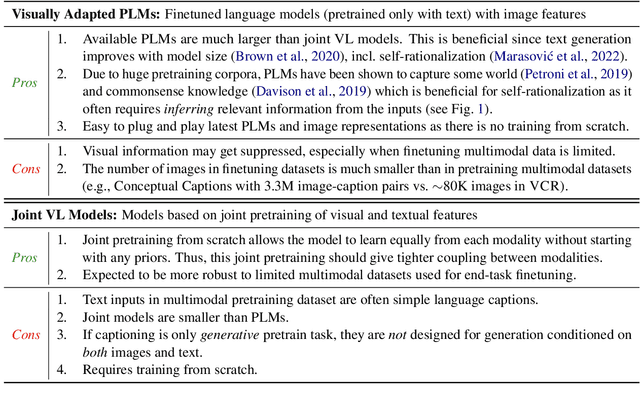

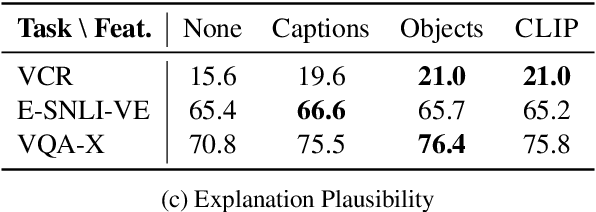
Abstract:Integrating vision and language has gained notable attention following the success of pretrained language models. Despite that, a fraction of emerging multimodal models is suitable for text generation conditioned on images. This minority is typically developed and evaluated for image captioning, a text generation task conditioned solely on images with the goal to describe what is explicitly visible in an image. In this paper, we take a step back and ask: How do these models work for more complex generative tasks, conditioned on both text and images? Are models based on joint multimodal pretraining, visually adapted pretrained language models, or models that combine these two approaches, more promising for such tasks? We address these questions in the context of self-rationalization (jointly generating task labels/answers and free-text explanations) of three tasks: (i) visual question answering in VQA-X, (ii) visual commonsense reasoning in VCR, and (iii) visual-textual entailment in E-SNLI-VE. We show that recent advances in each modality, CLIP image representations and scaling of language models, do not consistently improve multimodal self-rationalization of tasks with multimodal inputs. We also observe that no model type works universally the best across tasks/datasets and finetuning data sizes. Our findings call for a backbone modelling approach that can be built on to advance text generation from images and text beyond image captioning.
Robustness of Neural Architectures for Audio Event Detection
May 06, 2022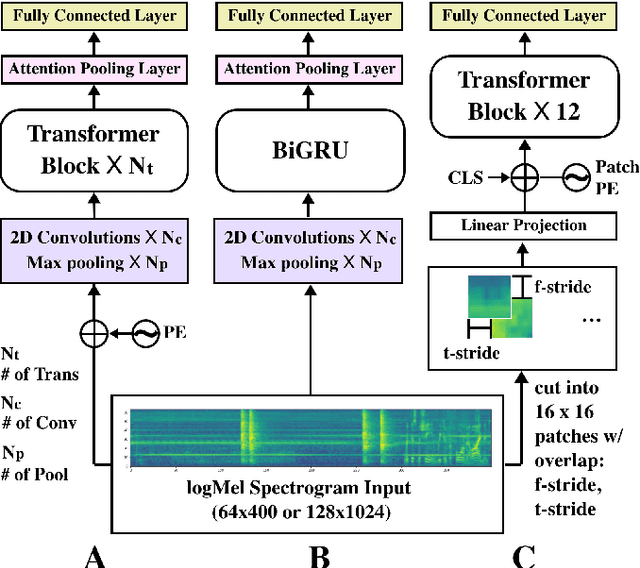
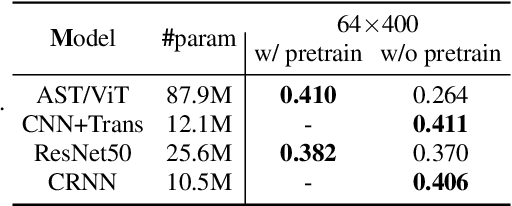
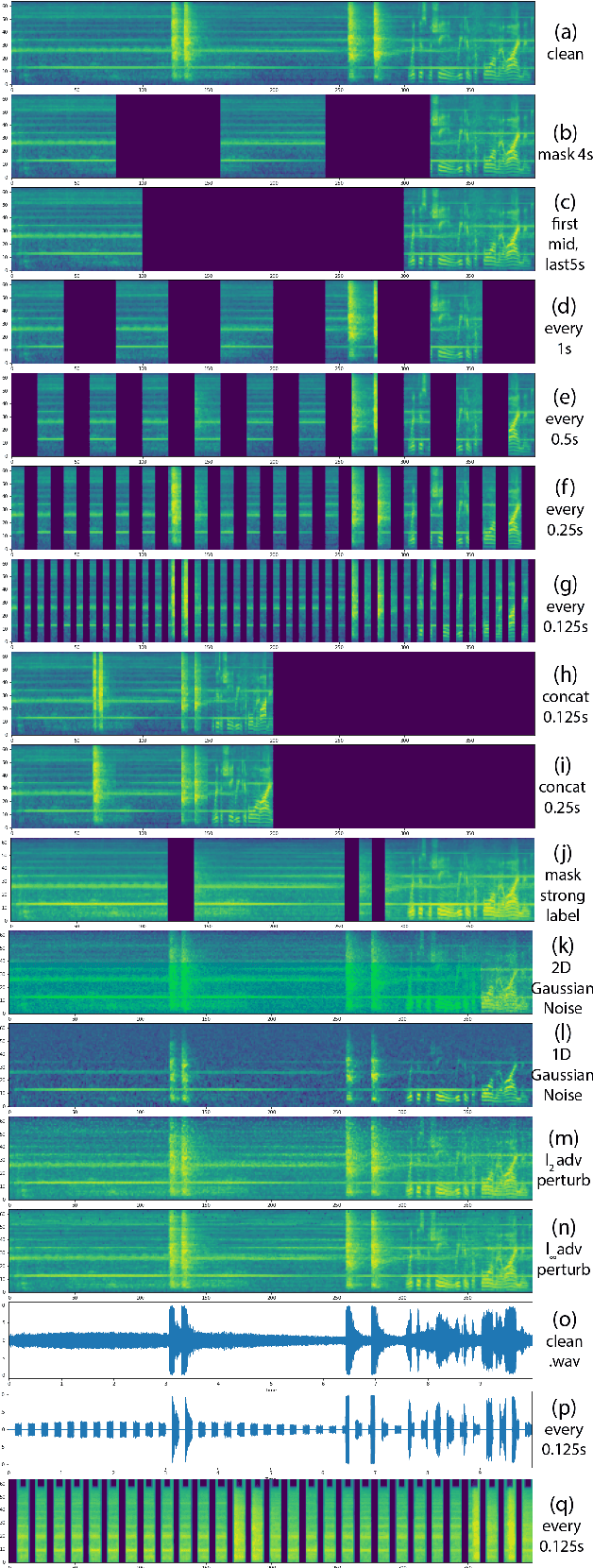
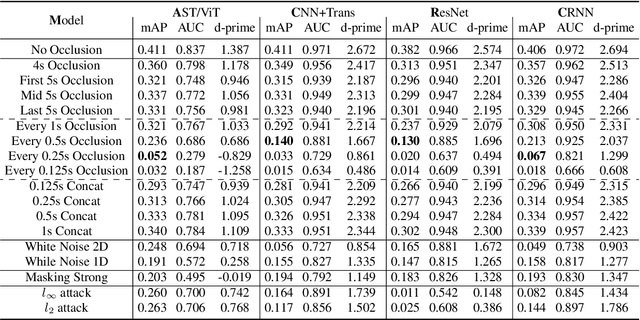
Abstract:Traditionally, in Audio Recognition pipeline, noise is suppressed by the "frontend", relying on preprocessing techniques such as speech enhancement. However, it is not guaranteed that noise will not cascade into downstream pipelines. To understand the actual influence of noise on the entire audio pipeline, in this paper, we directly investigate the impact of noise on a different types of neural models without the preprocessing step. We measure the recognition performances of 4 different neural network models on the task of environment sound classification under the 3 types of noises: \emph{occlusion} (to emulate intermittent noise), \emph{Gaussian} noise (models continuous noise), and \emph{adversarial perturbations} (worst case scenario). Our intuition is that the different ways in which these models process their input (i.e. CNNs have strong locality inductive biases, which Transformers do not have) should lead to observable differences in performance and/ or robustness, an understanding of which will enable further improvements. We perform extensive experiments on AudioSet which is the largest weakly-labeled sound event dataset available. We also seek to explain the behaviors of different models through output distribution change and weight visualization.
AudioTagging Done Right: 2nd comparison of deep learning methods for environmental sound classification
Apr 03, 2022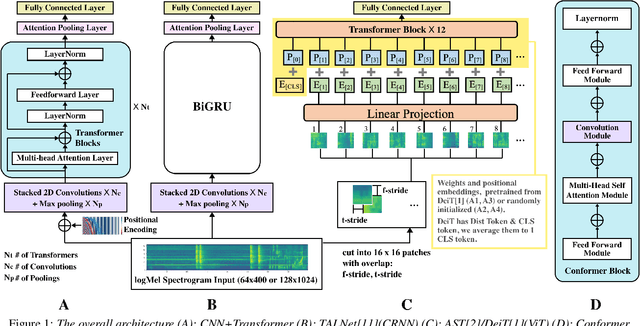
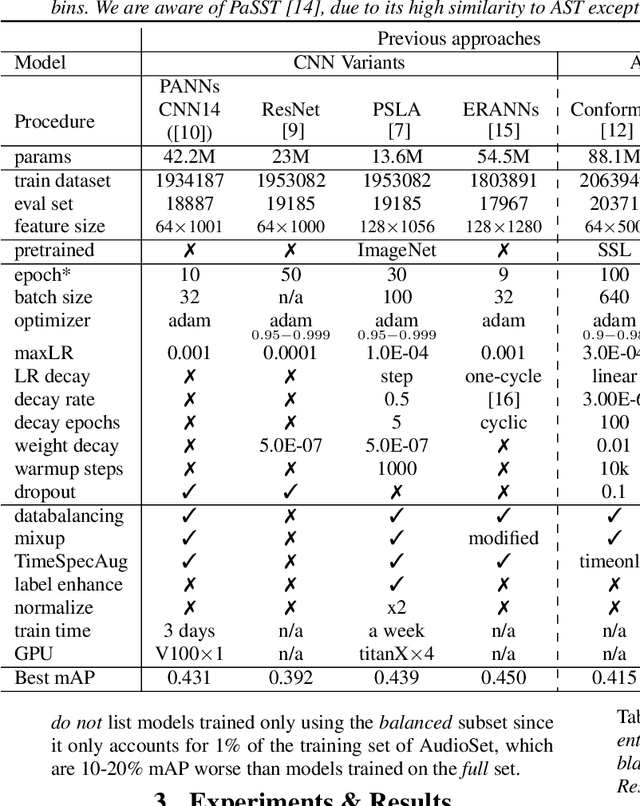
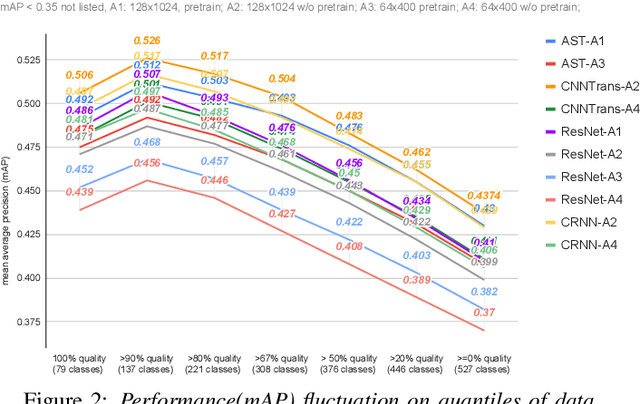
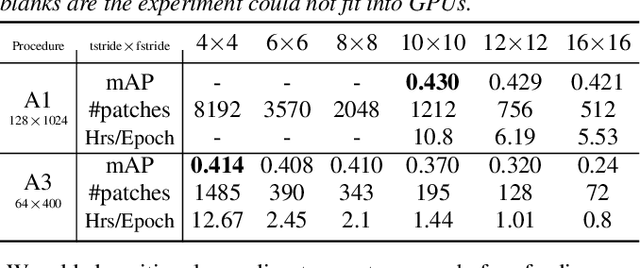
Abstract:After its sweeping success in vision and language tasks, pure attention-based neural architectures (e.g. DeiT) are emerging to the top of audio tagging (AT) leaderboards, which seemingly obsoletes traditional convolutional neural networks (CNNs), feed-forward networks or recurrent networks. However, taking a closer look, there is great variability in published research, for instance, performances of models initialized with pretrained weights differ drastically from without pretraining, training time for a model varies from hours to weeks, and often, essences are hidden in seemingly trivial details. This urgently calls for a comprehensive study since our 1st comparison is half-decade old. In this work, we perform extensive experiments on AudioSet which is the largest weakly-labeled sound event dataset available, we also did an analysis based on the data quality and efficiency. We compare a few state-of-the-art baselines on the AT task, and study the performance and efficiency of 2 major categories of neural architectures: CNN variants and attention-based variants. We also closely examine their optimization procedures. Our opensourced experimental results provide insights to trade-off between performance, efficiency, optimization process, for both practitioners and researchers. Implementation: https://github.com/lijuncheng16/AudioTaggingDoneRight
On Adversarial Robustness of Large-scale Audio Visual Learning
Mar 23, 2022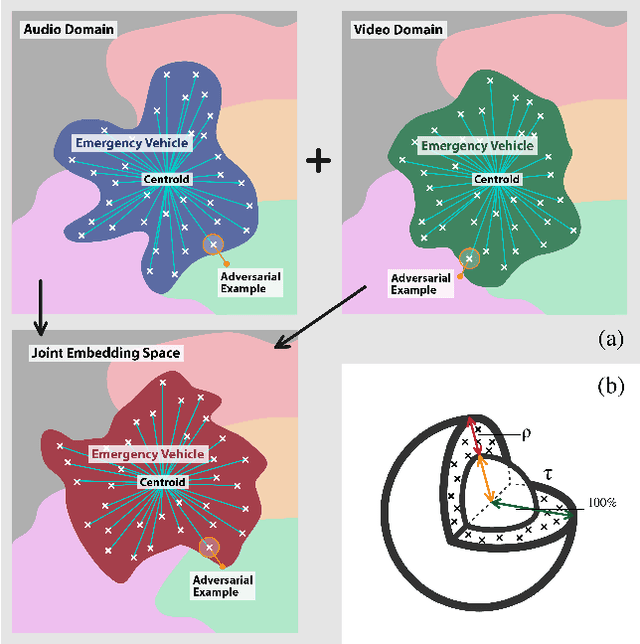
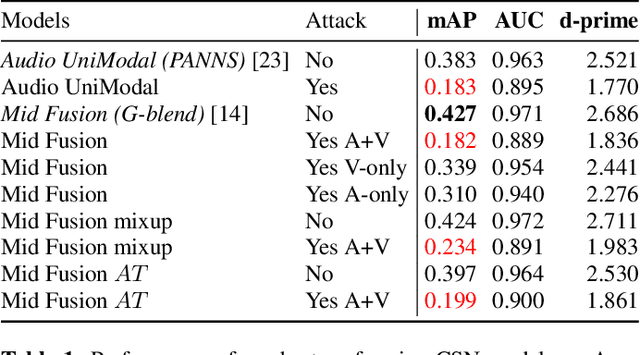
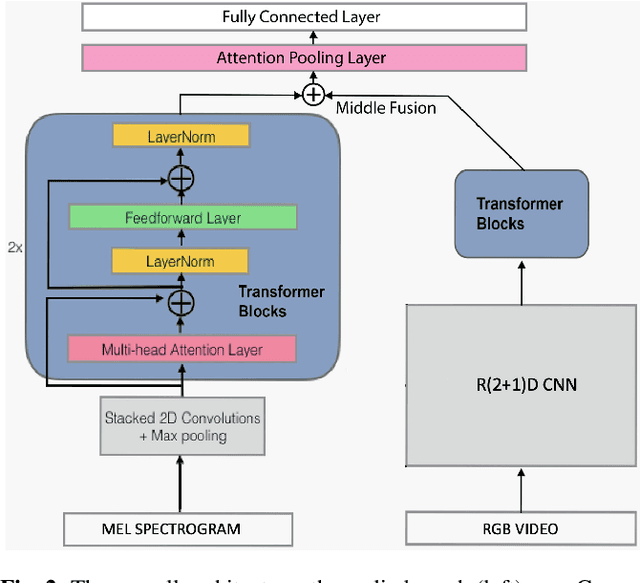
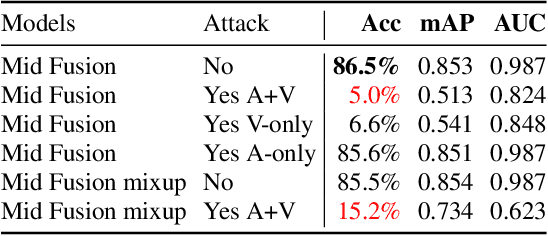
Abstract:As audio-visual systems are being deployed for safety-critical tasks such as surveillance and malicious content filtering, their robustness remains an under-studied area. Existing published work on robustness either does not scale to large-scale dataset, or does not deal with multiple modalities. This work aims to study several key questions related to multi-modal learning through the lens of robustness: 1) Are multi-modal models necessarily more robust than uni-modal models? 2) How to efficiently measure the robustness of multi-modal learning? 3) How to fuse different modalities to achieve a more robust multi-modal model? To understand the robustness of the multi-modal model in a large-scale setting, we propose a density-based metric, and a convexity metric to efficiently measure the distribution of each modality in high-dimensional latent space. Our work provides a theoretical intuition together with empirical evidence showing how multi-modal fusion affects adversarial robustness through these metrics. We further devise a mix-up strategy based on our metrics to improve the robustness of the trained model. Our experiments on AudioSet and Kinetics-Sounds verify our hypothesis that multi-modal models are not necessarily more robust than their uni-modal counterparts in the face of adversarial examples. We also observe our mix-up trained method could achieve as much protection as traditional adversarial training, offering a computationally cheap alternative. Implementation: https://github.com/lijuncheng16/AudioSetDoneRight
Speech Summarization using Restricted Self-Attention
Oct 12, 2021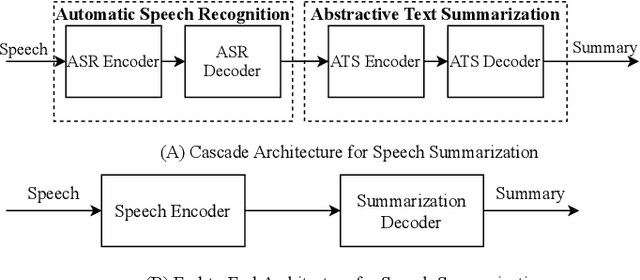



Abstract:Speech summarization is typically performed by using a cascade of speech recognition and text summarization models. End-to-end modeling of speech summarization models is challenging due to memory and compute constraints arising from long input audio sequences. Recent work in document summarization has inspired methods to reduce the complexity of self-attentions, which enables transformer models to handle long sequences. In this work, we introduce a single model optimized end-to-end for speech summarization. We apply the restricted self-attention technique from text-based models to speech models to address the memory and compute constraints. We demonstrate that the proposed model learns to directly summarize speech for the How-2 corpus of instructional videos. The proposed end-to-end model outperforms the previously proposed cascaded model by 3 points absolute on ROUGE. Further, we consider the spoken language understanding task of predicting concepts from speech inputs and show that the proposed end-to-end model outperforms the cascade model by 4 points absolute F-1.
VideoCLIP: Contrastive Pre-training for Zero-shot Video-Text Understanding
Oct 01, 2021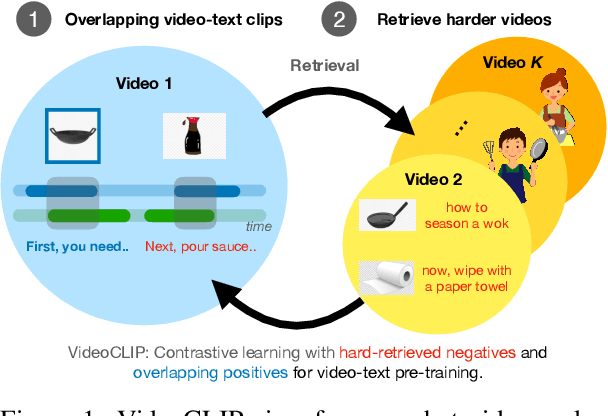
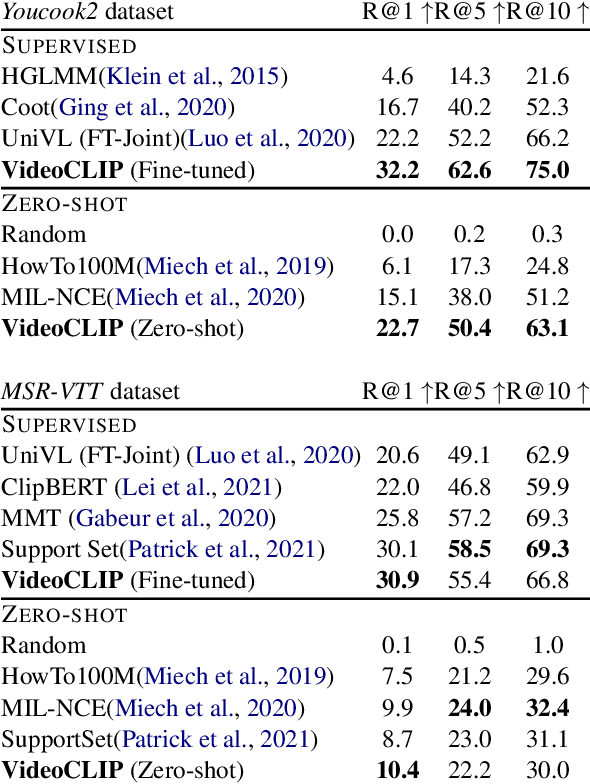
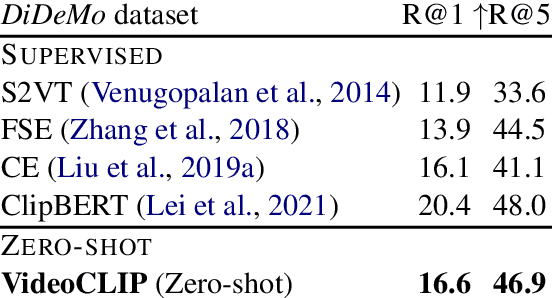
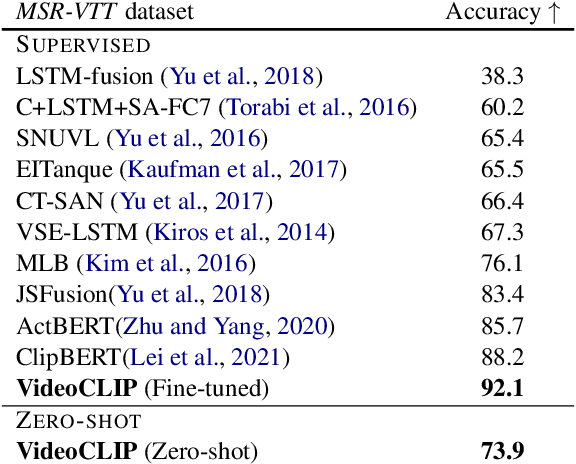
Abstract:We present VideoCLIP, a contrastive approach to pre-train a unified model for zero-shot video and text understanding, without using any labels on downstream tasks. VideoCLIP trains a transformer for video and text by contrasting temporally overlapping positive video-text pairs with hard negatives from nearest neighbor retrieval. Our experiments on a diverse series of downstream tasks, including sequence-level text-video retrieval, VideoQA, token-level action localization, and action segmentation reveal state-of-the-art performance, surpassing prior work, and in some cases even outperforming supervised approaches. Code is made available at https://github.com/pytorch/fairseq/tree/main/examples/MMPT.
Differentiable Allophone Graphs for Language-Universal Speech Recognition
Jul 24, 2021


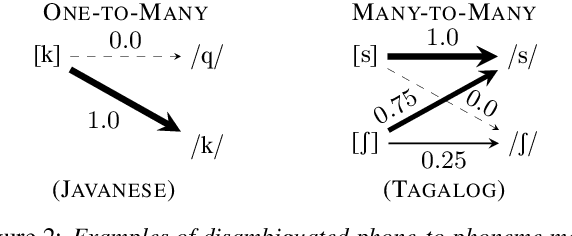
Abstract:Building language-universal speech recognition systems entails producing phonological units of spoken sound that can be shared across languages. While speech annotations at the language-specific phoneme or surface levels are readily available, annotations at a universal phone level are relatively rare and difficult to produce. In this work, we present a general framework to derive phone-level supervision from only phonemic transcriptions and phone-to-phoneme mappings with learnable weights represented using weighted finite-state transducers, which we call differentiable allophone graphs. By training multilingually, we build a universal phone-based speech recognition model with interpretable probabilistic phone-to-phoneme mappings for each language. These phone-based systems with learned allophone graphs can be used by linguists to document new languages, build phone-based lexicons that capture rich pronunciation variations, and re-evaluate the allophone mappings of seen language. We demonstrate the aforementioned benefits of our proposed framework with a system trained on 7 diverse languages.
Rethinking End-to-End Evaluation of Decomposable Tasks: A Case Study on Spoken Language Understanding
Jun 29, 2021
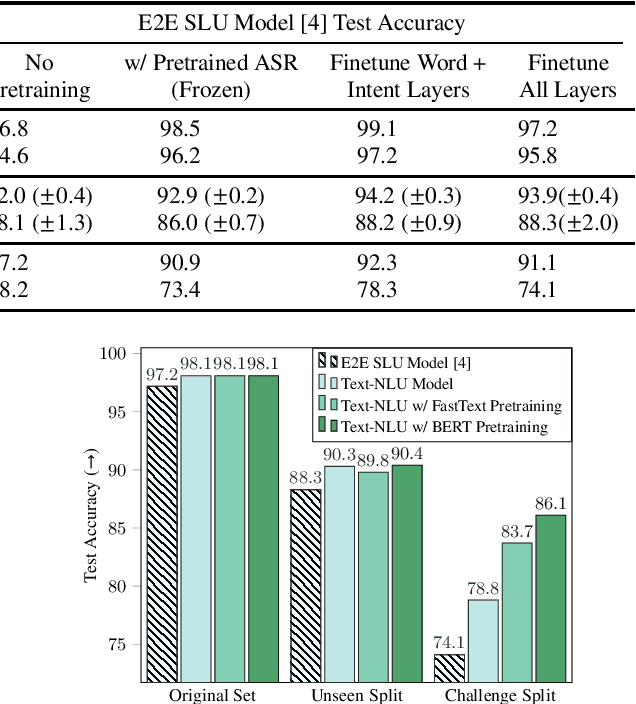
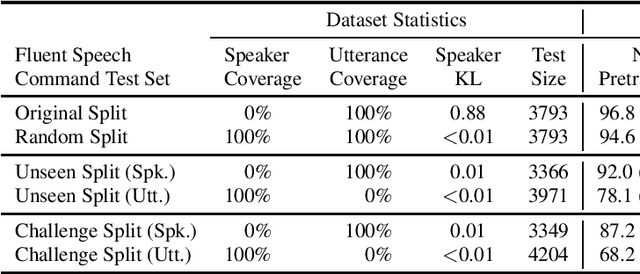

Abstract:Decomposable tasks are complex and comprise of a hierarchy of sub-tasks. Spoken intent prediction, for example, combines automatic speech recognition and natural language understanding. Existing benchmarks, however, typically hold out examples for only the surface-level sub-task. As a result, models with similar performance on these benchmarks may have unobserved performance differences on the other sub-tasks. To allow insightful comparisons between competitive end-to-end architectures, we propose a framework to construct robust test sets using coordinate ascent over sub-task specific utility functions. Given a dataset for a decomposable task, our method optimally creates a test set for each sub-task to individually assess sub-components of the end-to-end model. Using spoken language understanding as a case study, we generate new splits for the Fluent Speech Commands and Snips SmartLights datasets. Each split has two test sets: one with held-out utterances assessing natural language understanding abilities, and one with held-out speakers to test speech processing skills. Our splits identify performance gaps up to 10% between end-to-end systems that were within 1% of each other on the original test sets. These performance gaps allow more realistic and actionable comparisons between different architectures, driving future model development. We release our splits and tools for the community.
 Add to Chrome
Add to Chrome Add to Firefox
Add to Firefox Add to Edge
Add to Edge